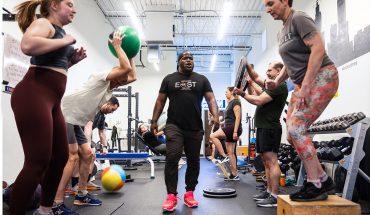by Charman Driver
photograph by Mark Petko
“Move as if your body is seaweed, and water is washing over you,” says Chelsea Jones.
I close my eyes and imagine what it looks (and feels) like to move like washed-over-seaweed. Here goes nothing …
I am standing, legs hip-distance apart, one foot in front of the other. Jones has guided my hands in to long straps connected to a peculiar piece of equipment called the pulley tower.
Jones is showing me how to perform a kind of exercise not known to many: Gyrotonic. Created by a Hungarian ballet dancer in the early ’80s to help recover from injury, it’s based on circular – not linear – movement in all directions.
My arms are wide and lifted skyward, and my chest is thrust forward. I begin to move with fluidity and rhythm, back and forth – a continuous motion in my body that really does simulate seaweed as water washes over it. At least I think so.
The pulley machine helps facilitate the graceful movements, but I am doing all the work. It’s not easy, but it feels good, and it feels natural – sort like swimming without water.
Gyrotonic, Jones says, creates strength and mobility around all of the joints and girdles of the body in three dimensions. It’s unique for sure, but it merges principles from other forms of movement that are very familiar to us, like yoga, dance, gymnastics, swimming, and tai chi.
The weight- and pulley-based equipment – which includes machines like a pulley tower, jumping-stretching board, leg extension unit, gyrotoner, and archway – make it possible to achieve flowing, dancer-like movements.
Jones is a one of the pioneers of this method in Raleigh. The CEO of Evolve Movement – which has two area studios devoted to Pilates, yoga, and Gyrotonic – she was one of the first practitioners in the area when she introduced it in 2002.
“It is a beautiful complement to Pilates,” she says, because it allows the body to flow freely between contraction and extension, like swimming or dance.
“By comparison, the Pilates Method is more linear and focuses on teaching girdle stability, “ she says. “Both techniques are super-important.”
Gyrotonic’s circular, fluid exercises work the entire body and are said to promote strong, lean muscles; increase flexibility, coordination, and balance; enhance joint mobility, renew energy and vitality; and promote a sense of calm and well being.
For me, the circular, spiraling motions, and breathing (which I learned is deeply rooted in yoga) helped relax my tight muscles and stiff joints. It felt particularly yummy in my back, as this method allows the spine to move in all directions, which is great for improving back strength and flexibility.
It’s also suitable for just about anybody. Jones says elite athletes, movers, and dancers can get an intense physical workout from Gyrotonic; older people or those with autoimmune disease can benefit from a gentler session; and those with injuries can use the system therapeutically.
For more information about Gyrotonic, go to
www.Gyrotonic.com. For information about Gyrotonic training at Evolve, go to www.evolvemovement.com.




